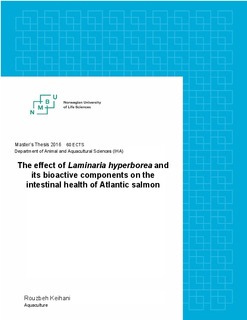| dc.description.abstract | The rapid expansion of the aquaculture industry is imposing an increasing demand on the available feed resources for aquafeeds, particularly fishmeal. Plant-derived ingredients have been widely investigated in recent years as alternative protein and energy sources. Nevertheless, anti-nutritional factors present in plant ingredients can lead to reduced growth performance and affect gut health and function. In recent years, research has shown that certain feed ingredients and additives prevent or ameliorate the negative effects of some plant-derived anti-nutrients on gut health. Marine algae contain a variety of novel polysaccharides, which are highly bioactive and can be used as a new line of functional dietary supplements. In this study, the salmonid soy bean meal induced enteritis model has been used to investigate the effect of dietary inclusion of brown seaweed Laminaria hyperborea (LH) and two extracted bioactive compounds, fucoidan and laminarin, on the intestinal health of Atlantic salmon. The LH extract was obtained by incubation of ground LH in 0.03 M HCl for an hour at 70°C. CaCl2 was used to precipitate alginate from the extract. Crude fucoidan and laminarin were obtained by step-wise filtration of the extract through spiral membranes with molecular weight cut offs at 100, 50, 25, 10 and 2 kDa. Six diets were formulated and extruded for this experiment. The dietary treatments were a fish meal (FM)-based diet as a negative control, a soybean meal (SBM)-based diet as a positive control, a test diet containing 5% LH, as well as three test diets containing either fucoidan or laminarin or both in concentration of 0.075%. All diets except for the fish meal based diet were formulated to contain 20% SBM. There were triplicate tanks per dietary treatment and 18 tanks in total with 12 fish per tank. At the end of the experimental period, the fish were sacrificed and the distal intestine (DI), liver, mid kidney, spleen, skin, feces and blood were collected from 4 fish per tank. There was no significant difference in the growth performance of fish fed the experimental diets. However, a large intra-treatment variation in the performance of fish was observed. Fish fed the FM-based diet showed significantly lower signs of inflammation compared to the fish fed other dietary treatments, while fish fed the SBM-based diet and the test diets with LH and the bioactive components showed clear signs of enteritis. To conclude, the dietary inclusion of LH and the bioactive compounds had no significant amelioration effect on inflammation. | nb_NO |

